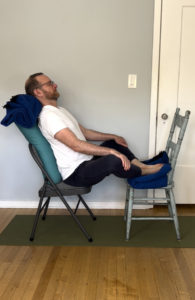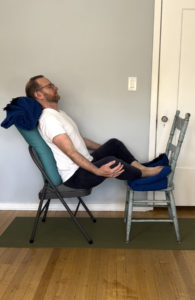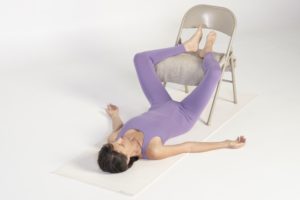
by Jivana Heyman
In modern yoga, it’s easy to forget that more subtle is more advanced and that stillness is strength. Yoga asks us to get so quiet that we can hear our heart speak, and that is one of the greatest challenges of them all. Restorative yoga offers us support for this inward journey, and in this way holds tremendous potential.
But also it’s important to acknowledge the challenges and obstacles to practicing restorative yoga in order to make it truly accessible. These challenges and obstacles include physical challenges as well as mental and emotional ones.
On the physical level, it can be challenging to hold a pose for an extended period of time regardless of how much support you have or how comfortable it may seem when you first enter the pose. So having the freedom to adjust the pose, to move as needed, and to come out of a pose whenever you want is essential in restorative yoga—as it is in any yoga class. Practitioners should always feel free to do this and teachers of restorative yoga should always encourage their students to do so as well.
Also, having access to enough props, and the right ones, can sometimes be challenging. Not everyone can find the physical space in their home that is needed for such a prop-intensive practice. If possible, studio owners and teachers should make an effort to provide enough props so everyone can be comfortable. Also, there are many common household items that can be used in restorative yoga; bed pillows, couch cushions, blankets, and towels are all extremely useful. Also, chairs, stools, and coffee tables can be great props as well.
Disabled people, those with larger bodies, seniors, and many others may need specific supports that aren’t typically offered in a public class. For example, many seniors aren’t comfortable lying flat on their backs on a mat, so it can be helpful to always have the head and upper back slightly elevated when practicing restorative yoga.
Of course, not everyone can get on the floor, so it’s important to offer options in a chair for those practicing in a classroom. For example, Supta Baddha Konasana (Reclined Cobbler’s pose) is a popular restorative pose that can be made more accessible in a few ways. A chair version can be done by using a second chair or a stool in front of you and a bolster behind your back and a blanket behind your neck to allow you to rest back.

Note that many chair yoga practitioners need to keep one foot down on the floor at all times to avoid falls. In fact, this is a rule for many exercise and yoga classes offered in senior housing or other senior settings. So this pose could be done one leg at a time if that rule applies or if stretching both legs at the same time is too intense.
To practice this variation, start by setting up your two chairs or a chair and a stool so they are facing each other and are fairly close together. Then add the props, with the bolster and rolled blanket on the first chair and a folded blanket on the second chair or stool.
If you are able to practice with both feet off the floor, bend your knees and bring one foot at a time onto the seat of the second chair or stool so both feet are fully supported. Slowly bring the soles of your feet together as you open the knees to the sides, allowing them to relax towards the floor.
If you wish, you can hold the legs with your hands to help control the movement. Your hands can support the knees if the stretch is too intense or they can gently press on the inner thighs to increase the stretch.

When your legs are comfortable, lean back onto the bolster and move the rolled blanket so it supports your neck. Then relax as you let all the props support you.
This ability to reduce or deepen a stretch is an extremely important point to note in restorative yoga because the poses are held for much longer than in an active practice. If, after a minute or so in a pose, you begin to feel a strain, use your hands to support the knees, reducing the stretch slightly. This may allow you to stay in the pose safely for a longer period of time.
For those who can get to the floor, a more accessible version than the classic Reclined Cobbler’s pose can be done on the mat.

I recommend using a blanket under the head for this because it is an inversion of the lower body. For some people, even a gentle inversion can increase the feeling of pressure in the head, and this small support can eliminate that feeling. This is especially true if you have high blood pressure or any form of heart disease.
To practice this variation, begin by lying on the floor in front of the chair with your lower legs resting on the seat of a chair. Then bring your feet to the front of the seat of the chair with the knees deeply bent. Slowly open the knees, lowering them towards the floor. Again, you can control the amount of stretch on the inner thighs with the hands by either supporting the thighs to limit the stretch, or by holding the inner thighs with the hands and allowing the weight of your arms to increase the stretch.
Another option for the legs that may be more relaxing because the legs are supported is to leave your calves on the chair seat, but move your knees wide apart and bring your feet together (or almost together) into a Cobbler’s pose position, as shown in this photo.

For those practicing at home who can’t get on the floor, you can practice with chairs at home, but there is also the possibility of practicing on a couch or in bed. The softness of a couch or bed can be extra comforting in restorative yoga, but it also offers less resistance which can change the experience in other ways. It can make it harder to come in and out of poses, and also require additional props to support the body so that the practice is safe and effective.
So if you’re practicing on a couch or bed, take your time moving in and out of the poses and provide yourself with extra props within easy reach in case you need them. In particular, notice the position of your neck and lower back. You want to avoid feeling like those areas are sinking into the bed or couch. You can add extra support for those areas with towels, blankets, or pillows. These would be low supports, such as a folded hand towel under the lumbar area, or a low blanket or narrow pillow under the neck.
On the mental and emotional level all the essential teachings around trauma come into play when practicing restorative yoga. To ask someone to rest deeply they have to feel safe, and the experience of safety is highly personal. Trauma-informed teaching is the process of working collaboratively with a student to help them cultivate personal agency in a yoga class, and in their personal practice. For example, a student might feel safer with a blanket covering them or keeping their eyes open in the pose. And if you’re practicing on your own at home, you should feel free to make whatever adjustments make you most comfortable.
With the power of choice and a sense of safety, a restorative yoga practice can offer us a path inward. This is a path that brings us back home to ourselves. We get to explore asana in the classical sense—as a steady and comfortable pose. Through asana we can become aware of the breath and then the mind and emotions. With practice, we can connect to our very essence and experience yoga as a state of being. Restorative yoga offers a deep and potentially transformational practice for all of us.
For those of you who would like to learn more about how to make restorative yoga accessible to everyone, Accessible Yoga is offering an eight-part online workshop called Restorative Yoga Series: Making Rest Practices Accessible that explores the obstacles to making yoga’s rest practices truly accessible for everyone who is interested in practicing them and offers a range of solutions.
Dates and Times: April 12 – May 5, 2023, Wednesdays & Fridays, 1pm-3pm PT/4pm-6pm ET
Teachers: Tamika Caston-Miller, Tejal Patel, Cheri Clampett, Shannon Kaneshige, Indu Arora, Shawn J Moore, Marlysa Sullivan, and Jivana Heyman.
For more information or to register, go here: https://www.accessibleyogaschool.com/restorative-series. I hope some of you will join us.
For more information on Jivana Heyman and his work with Accessible Yoga, go to https://www.accessibleyoga.org/ and https://www.accessibleyogaschool.com/
• Follow Yoga for Healthy Aging on Facebook and follow Nina on Instagram • Order Yoga for Times of Change here and purchase the companion videos here • Order Yoga for Healthy Aging: A Guide to Lifelong Well-Being here


I love this thorough explanation and demonstration of how to offer accessibility in Baddha Konasana. I love even more the definition of what “advanced” means, and “strength.” Thank you for the gentle reminder of what yoga is for, and why we practice!
Wonderful suggestions, Jivana! I really appreciate your creative ideas about how we can vary poses to all bodies and needs (as well as the reminder to do so).